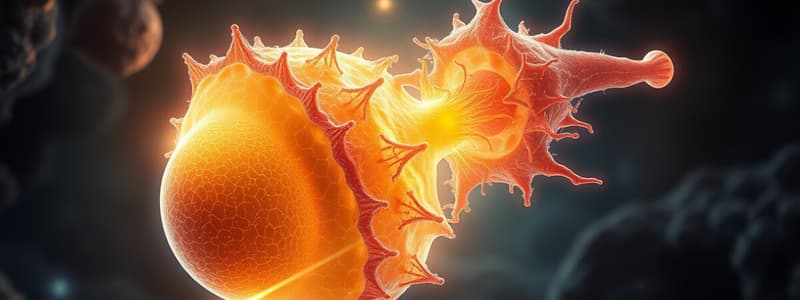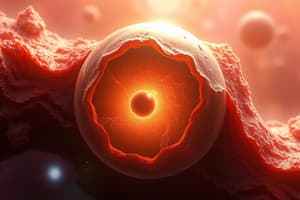Podcast
Questions and Answers
What structure is formed from epiblast cells that move cranially?
What structure is formed from epiblast cells that move cranially?
- Definitive endoderm
- Mesoderm
- Oropharyngeal membrane (correct)
- Notochord
What happens to the hypoblast during the invagination of epiblast cells?
What happens to the hypoblast during the invagination of epiblast cells?
- It is replaced by mesoderm.
- It becomes part of the oropharyngeal membrane.
- It is displaced to form definitive endoderm. (correct)
- It fuses with the epiblast.
Which structure indicates the potential future opening of the oral cavity?
Which structure indicates the potential future opening of the oral cavity?
- Primitive streak
- Precordial plate
- Oropharyngeal membrane (correct)
- Amniotic cavity
At the end of the second week of development, what is primarily visible on the dorsal side of the embryo?
At the end of the second week of development, what is primarily visible on the dorsal side of the embryo?
What does the precordial plate induce during embryonic development?
What does the precordial plate induce during embryonic development?
Which timeframe corresponds to the formation of the trilaminar germ disc?
Which timeframe corresponds to the formation of the trilaminar germ disc?
What main process occurs when the epiblast cells move inward?
What main process occurs when the epiblast cells move inward?
Which layer replaces the hypoblast after the inward movement of epiblast cells?
Which layer replaces the hypoblast after the inward movement of epiblast cells?
What structure serves as the definitive chord in the development of the axial skeleton?
What structure serves as the definitive chord in the development of the axial skeleton?
At what developmental stage does the left-right axis (LR) occur?
At what developmental stage does the left-right axis (LR) occur?
Which factor is necessary for the ventralization of the mesoderm that contributes to kidney formation?
Which factor is necessary for the ventralization of the mesoderm that contributes to kidney formation?
What forms at the caudal end of the embryonic disc during early development?
What forms at the caudal end of the embryonic disc during early development?
What does the anterior-posterior (AP) axis formation lead to at the cranial end of the endoderm?
What does the anterior-posterior (AP) axis formation lead to at the cranial end of the endoderm?
What role do mesoderm cells play in the development of the prechordal plate?
What role do mesoderm cells play in the development of the prechordal plate?
Which of the following statements accurately describes the notochordal plate formation?
Which of the following statements accurately describes the notochordal plate formation?
Which structure is formed through the migration of prenotochordal cells?
Which structure is formed through the migration of prenotochordal cells?
What is the relationship between the tropoblast and the placenta?
What is the relationship between the tropoblast and the placenta?
What does the primary villi contribute to in embryonic development?
What does the primary villi contribute to in embryonic development?
How do epiblast cells contribute to the structure of the notochordal plate?
How do epiblast cells contribute to the structure of the notochordal plate?
What happens when the notochordal plate detaches from the endoderm?
What happens when the notochordal plate detaches from the endoderm?
What is the primary role of the mesoderm germ layer?
What is the primary role of the mesoderm germ layer?
What function does the connecting stalk serve during the embryonic development?
What function does the connecting stalk serve during the embryonic development?
Which factors are involved in the induction of the neural plate?
Which factors are involved in the induction of the neural plate?
What occurs during the process of neurulation?
What occurs during the process of neurulation?
At what developmental stage does the anterior cranial neuropore close?
At what developmental stage does the anterior cranial neuropore close?
What does the endoderm germ layer primarily give rise to?
What does the endoderm germ layer primarily give rise to?
Which structure forms at the midline during the fusion of the neural folds?
Which structure forms at the midline during the fusion of the neural folds?
What is the significance of the notochord in embryonic development?
What is the significance of the notochord in embryonic development?
Which stage is described as being 1.25 mm long and 0.68 mm wide in embryo development?
Which stage is described as being 1.25 mm long and 0.68 mm wide in embryo development?
What is the role of nodal in embryonic development?
What is the role of nodal in embryonic development?
Which factor is primarily responsible for the restriction of nodal expression to the left side of the embryo?
Which factor is primarily responsible for the restriction of nodal expression to the left side of the embryo?
What does situs inversus refer to in the context of organ placement?
What does situs inversus refer to in the context of organ placement?
Which condition is characterized by the heart being located on the right side instead of the left?
Which condition is characterized by the heart being located on the right side instead of the left?
What can result from abnormal expression of nodal during embryonic development?
What can result from abnormal expression of nodal during embryonic development?
What is the primary process that leads to the formation of the neural tube?
What is the primary process that leads to the formation of the neural tube?
Which of the following best describes the function of TGF B?
Which of the following best describes the function of TGF B?
How does the primitive streak relate to the overall structure of the embryo?
How does the primitive streak relate to the overall structure of the embryo?
Study Notes
Epiblast Cell Movements
- Epiblast cells migrate laterally, cranially, and caudally.
- Cranially migrating cells form the precordial plate, which induces forebrain development.
- The oropharyngeal membrane marks the future opening of the oral cavity.
Germ Disc and Development
- The dorsal side of a 16-day embryo shows movement of surface epiblast cells; the primitive streak creates a shallow groove in the caudal region.
- By day 15, epiblast invagination displaces hypoblast cells, establishing definitive endoderm.
- Epiblast gives rise to three germ layers: ectoderm, mesoderm, and endoderm, contributing to organogenesis.
Nutritional Support
- Primary villi, villous capillaries, and connecting stalk (chorionic plate) supply nutrients and oxygen.
- The trophoblast will develop into the placenta, essential for embryonic nourishment.
Notochord Formation
- Notochordal plate detachment from the endoderm defines the formation of the definitive notochord.
- Prenotochordal cells invaginate, extending cranially to the precordial plate and caudally to the primitive pit.
Body Axes Establishment
- Body axes include anterior-posterior (AP), dorso-ventral (DV), and left-right (L-R) orientations.
- The anterior visceral endoderm (AVE) appears at the cranial end, marking the head region.
- Nodal is crucial for initiating and maintaining the primitive streak; improper nodal expression leads to defects like situs inversus and dextrocardia.
Molecular Regulation of Neural Induction
- Neurulation involves the neural plate forming the neural tube, initiated by FGF upregulation and BMP4 inhibition.
- Neural folds elevate to create the neural groove, eventually fusing to form the neural tube.
- Anterior cranial neuropore closes by day 25; posterior neuropore closes by day 28.
Derivatives of Germ Layers
- Mesoderm: Supports tissues such as myotomes (muscle), sclerotomes (cartilage), and dermatomes (skin).
- Endoderm: Forms internal organs, including the gastrointestinal tract, respiratory tract, and glands like the liver and pancreas.
Studying That Suits You
Use AI to generate personalized quizzes and flashcards to suit your learning preferences.
Related Documents
Description
This quiz covers key concepts related to epiblast cell movements, germ disc structure, and the role of nutritional support in embryonic development. It explores the formation of the notochord and its significance in organogenesis, as well as the differentiation of the germ layers. Test your understanding of these fundamental embryological processes!


